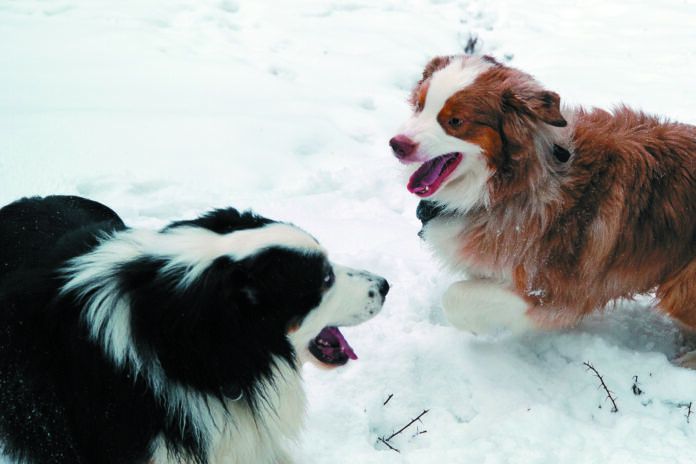Dogs are lovers, not fighters. They are genetically primed to get along with each other — to explore together, to play with each other, and to relax in each other’s presence. But some dogs haven’t been socialized to understand other dogs. They may have had a bad experience with another dog as a puppy that was imprinted on their psyche very young, or they may not be feeling well. As a result, they can become anxious and prone to misunderstand cues from other dogs. And that can make them aggressive — to the point that they feel they have to attack to stay safe, even if they have not been provoked.
“The emergency department at Tufts’ Foster Hospital for Small Animals sees one or two bite cases a week from a dog-on-dog attack,” says John Berg, DVM, editor-in-chief of Your Dog. “The injuries are usually minor,” he says, “but we’ll get a severe one on the order of once a month.”
It’s more often a small dog that is brought in because of an attack from a big one, but small dogs can inflict harm, too, if their fear and subsequent aggression get the better of them — both on dogs of their own size and even on big dogs. Even a little dog’s teeth and jaws are more powerful than, say, ours. In fact, while big dogs are generally capable of causing the most damage, fear-based dog-on-dog aggression is a particular problem with small dogs, not just because their bites are capable of causing harm of their own but also because some people view the combination of a little pet and a tough demeanor as adorable. It’s not. “Seeing fearful or otherwise out-of-control aggressive behavior as cute neglects the very real emotional distress the dog is experiencing,” says the head of the Tufts Animal Behavior Clinic, Stephanie Borns-Weil, DVM.
Regardless of the size of the aggressor, what do you do if all of a sudden one dog attacks another and a fight ensues? What’s the best way to avoid harm for all concerned?
Is it really a fight?
It’s important to assess very quickly whether what you are seeing is a real fight or just play fighting. With play fighting, you’ll frequently notice very short pauses in the action. That’s a dog’s way of checking to make sure everything is okay and that he hasn’t misread the situation. Then the two of them are right back at it. If it’s truly a fight, on the other hand, there’s no stopping to take a breath. It’s all about fighting for your life — keeping the other dog from causing harm.
Dog roughhousing also has a certain mutuality to it. If it’s a fight rather than play wrestling, one of the dogs will be acting differently, and with a different affect, than the other. Perhaps he’ll be trying to move away, for instance.
Finally, if the two dogs are very different in size, look for the bigger one to modulate his behavior a little. If they’re playing, the bigger dog will get down low to be on the same level as the smaller one, and he’ll cut the smaller one some slack in allowing him to attack a little harder than he does. If they’re not playing, the big dog will not show deference.
You’re going to be able to figure all this out within a couple of seconds. It’s not going to take a lot of deliberation.
If it is in fact a fight…
Perhaps the hardest part of breaking up a fight between two dogs is acting as calmly as possible. You may not feel calm, but if you start screaming and making a fuss, it will only whip up the dogs even more. Not that such a reaction isn’t perfectly understandable. It’s just that it’s counterproductive. You, as mediator, can’t be contributing to the fray. Instead, try using your voice to give a firm command, such as “Leave it” or “Come.” Some dogs in a fight will grab the opportunity to disengage.
The second instinct to avoid is the one that tells you to try to grab the head or the neck of either dog. It’s logical to want to exert control over the area the bites are coming from — or where they’re being inflicted (an aggressor dog will frequently go for the other dog’s neck). But that puts your hands and potentially your own face right near the teeth, making you all the more likely to inadvertently end up on the receiving end of the aggression.
Your best bet is pushing an object between the dogs. A large branch or open umbrella may work if you are outside and away from home, while a baby gate or chair might work inside the house. You can also make a very loud noise with a whistle or burglar alarm or even by banging pots and pans together. Dumping a big pot of water or spraying them with the garden hose can also startle some dogs apart.
The late veterinarian Sophia Yin, DVM (author of the highly recommended book How to Behave So Your Dog Behaves), recommends getting the dogs by the rear end and pulling them away from each other. If one dog is small enough to carry, you can also try scooping him up, turning around, and moving away quickly — although some big dogs can easily jump as high as your arms.
You might also be able to place your foot on the rib cage of one of the dogs to push him off. It’s not kicking, which won’t work to separate the dogs. It’s simply to use the force of your leg to detach one dog from the other. Again, it leaves your hands and face away from either dog’s teeth.
It doesn’t always end well
No matter how calm you remain and no matter how deftly you protect yourself as you try to separate two fighting dogs, the altercation may not end without injuries. If it’s your dog who started the fight, it’s important to remember not to punish him for his actions, even by yelling. Dogs live very much in the moment and will not understand why you are angry or upset. You simply have to recommit to patient training — and avoid the situation in which the fight occurred. For example, it may be best not to let your dog off leash again until you and perhaps the trainer you’re working with feel very confident that he will make better choices with other dogs.
For some dogs who may never feel comfortable with other dogs, a leash becomes a permanent necessity whenever they leave the security of their own completely fenced-in backyard.
© Lightman_pic | Bigstock
Are they fighting or just play fighting? If they’re really fighting instead of roughhousing, one dog will have a different affect from the other and will perhaps try to move away. These dogs are clearly enjoying themselves.





